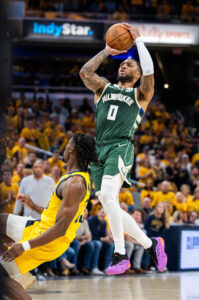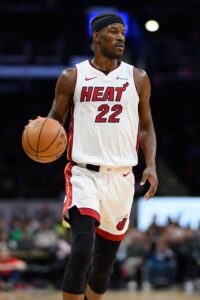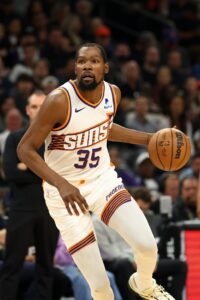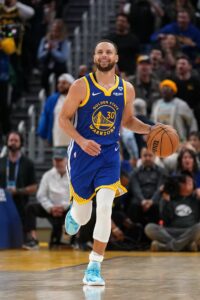It has now been five years since word broke in the middle of an early-July night that Kawhi Leonard, fresh off a championship run in Toronto, would be signing with the Clippers and would be joined by Paul George, who was being traded from Oklahoma City to Los Angeles.
The Clippers’ results across those five years have been solid relative to the team’s dismal overall track record — three of the top six winning percentages in the franchise’s 54-year history have come in the past five seasons. But it has been a disappointing stretch on the whole, given the championship aspirations the club has had since the two L.A. natives returned home in 2019.
 The Clippers have won just three playoff series with Leonard and George on the roster, making it beyond the first round only once, in 2021. Of course, making deep postseason runs is a challenge when one or both of your stars aren’t available. Leonard and George appeared in all 13 Clippers playoff games in 2020, but since then, at least one of them has missed some or all of every postseason.
The Clippers have won just three playoff series with Leonard and George on the roster, making it beyond the first round only once, in 2021. Of course, making deep postseason runs is a challenge when one or both of your stars aren’t available. Leonard and George appeared in all 13 Clippers playoff games in 2020, but since then, at least one of them has missed some or all of every postseason.
Leonard tore his ACL during the 2021 playoffs, which cost him the entire following season and the 2022 postseason too. A knee sprain sidelined George for the 2023 playoffs, while Leonard was able to suit up for just two of five first-round games. This past spring, George was healthy, but Leonard was available for just two of six first-round contests vs. Dallas, and was hampered by a knee issue when he did play.
Leonard’s and George’s injury problems, which have affected their availability during the regular season as well, have put a cap on what the Clippers are able to accomplish. But even if both players – and former MVPs James Harden and Russell Westbrook – were fully healthy during this year’s postseason, it’s unclear whether this roster had legitimate championship upside.
As good as those four guys (especially Leonard and George) still are when they’re performing at the peak of their powers, they’re not at the same level they were in their respective primes. The youngest player of the quartet, Leonard, will be 33 later this month. Kawhi is also the only one under contract for next season, with George and Westbrook holding player options for 2024/25 while Harden is headed for unrestricted free agency.
As they prepare to step out from the shadow of their more accomplished Crypto.com Arena co-tenants and move into their extravagant new Inglewood arena, the Clippers will want to do all they can to keep their championship window cracked open. Simply running it back with a roster that hasn’t won a playoff series since 2021 doesn’t feel satisfactory, but upgrading this group won’t be easy, given the limited resources the front office will have at its disposal.
The Clippers’ Offseason Plan
After extending Leonard in January and head coach Tyronn Lue, the Clippers will be focused in the coming weeks on new deals for George, Harden, and Westbrook.
Since Leonard agreed to a three-year, $152MM deal that was below his maximum in terms of both years and dollars (he could’ve gotten four years and $221MM), there has been a belief that the Clippers wanted to reach a similar agreement with George, who has had made the exact same salary as Kawhi in each of the past three seasons. But if George were willing to sign for the same amount as Leonard, that deal would likely already be done, which suggests he’s either pushing for a maximum salary (approximately $160MM over three years) or a fourth year — or both.
If they’re determined to keep him, the Clippers probably can’t afford to get too coy with the George negotiations, since the Sixers are believed to have made the star forward their No. 1 target and have more than enough cap room to offer him up to approximately $212MM over four years.
Will the Clippers tack on that fourth year? If so, they could top Philadelphia’s offer by about $9MM in total (they can’t offer a fifth year due to the Over-38 rule), but maybe the idea of playing with two younger stars (Joel Embiid and Tyrese Maxey) in a less competitive Eastern Conference appeals to George. While Embiid’s injury history has been viewed as a possible red flag for premier free agents who are considering the Sixers, it doesn’t look all that bad when stacked up next to Leonard’s.
Los Angeles’ ability to retain George could have an impact on what the team is willing to offer Harden, since bringing back both players would almost certainly push the Clippers’ team salary above the second tax apron, whereas just retaining one likely wouldn’t.
When Harden accepted a two-year, $68.6MM deal from the Sixers in 2022, it was viewed as a “hometown” discount, since he turned down a $47MM+ player option to sign that contract. But if Harden is expecting to make up the money he feels he gave up two years ago, he may be in for a rude awakening. Unlike George, Harden doesn’t seem to have another suitor looming as a threat to push his price tag higher (he didn’t last summer either, which is one reason why he accepted his second-year player option with Philadelphia instead of testing free agency).
The Clippers would likely be more aggressive with their offer for Harden if George walks, but if PG13 is in the fold, how high will L.A. go? Maybe $60MM over two years? $75MM over three? Harden is still a dynamic scorer and play-maker, but he’s entering his age-35 season and isn’t the same player he was in his prime, so the club will have to be careful about the later seasons of any multiyear deal. At the same time, we saw how quickly things turned sour in Philadelphia when Harden believed he wasn’t being properly valued, so the Clips won’t want to low-ball him.
Westbrook’s case isn’t any simpler. The 35-year-old is coming off a $3.8MM salary and will presumably decline his $4MM player option now that the Clippers hold his Early Bird rights and can offer him the sort of raise they couldn’t a year ago. But Westbrook was somewhat redundant on this roster following the acquisition of Harden, so assuming Harden returns, how enthusiastic will the Clippers be about giving Westbrook that raise? There are probably better fits for that roster spot, and from Westbrook’s perspective, there may be better fits around the NBA for his skill set.
Having taken a look at these three players’ situations, I should circle back and clarify one point — Clippers owner Steve Ballmer is the richest team owner in North American professional sports. If Lawrence Frank and the front office convince him that bringing back George, Harden, and Westbrook at any cost is the right move from the franchise, I can’t imagine Ballmer would hesitate to sign the necessary checks.
But giving those three players lucrative new contracts may not be in the Clippers’ best interests from a roster-building perspective, both because it would limit their options to address the rest of the roster and because the Harden/Westbrook fit was far from seamless. They’ll have to be wary about being dragged into a bidding war for any of those three FAs.
Evaluating the Clippers’ options to fill out the rest of the roster hinges in large part on what happens with their stars, since having George on the books for $49MM+ or having him leave for nothing would put the club in two very different positions from both a talent and financial perspective. Ditto for Harden.
If we assume George and Harden return, the Clippers would only be able to offer minimum-salary contracts to free agent targets and wouldn’t be able to aggregate salaries or take back more salary than they send out in a trade. They also wouldn’t be able to trade cash, and most of their future first-round picks are tied up due to previous deals. They could move their 2030 first-rounder and a 2031 swap, as well as their 2030 and 2031 second-rounders.
Norman Powell is one of the NBA’s most underrated shooters, having made 42.3% of 4.9 attempts per game since joining the Clippers. The floor spacing he provides is important, so I expect he’ll return. Ivica Zubac and Terance Mann are valuable role players at their current price point (around $11MM) and should remain in L.A. too.
On the other hand, P.J. Tucker, who will pick up a player option that’s also in the neighborhood of $11MM, is no longer a valuable asset at age 39. The Clippers will presumably explore moving him, but even attaching a first-round pick to his expiring deal might not bring back a high-level rotation player, since trade partners will be seeking draft compensation simply to take on Tucker’s unwanted contract.
Bones Hyland wasn’t a regular part of the Clippers’ rotation during his first full season with the club, but could take on a larger role if Westbrook departs. If Westbrook remains in L.A., Hyland could become a trade candidate.
Backup centers Mason Plumlee and Daniel Theis will be free agents and the Clippers probably don’t need to re-sign both guys — only one was in the rotation at the time for most of 2023/24. Since Los Angeles holds Plumlee’s Bird rights, he could be brought back at a higher salary, which could end up being useful for trade purposes. But if the Clippers aren’t in position to aggregate salaries anytime soon, it might make more sense to save some money and re-sign whichever big man is willing to return for the veteran’s minimum.
From there, the Clippers could head out onto the free agent market and see which other players might be willing to accept minimum deals to play for a potential contender in Los Angeles.
If George doesn’t return, the Clippers would be in position to potentially operate below the first tax apron, which would create new transaction opportunities for the front office — the mid-level ($12.9MM) and bi-annual ($4.7MM) exceptions would be available, and the team would have far more flexibility in trades, including the ability to aggregate salaries and take back more salary than is sent out.
Of course, with no cap room available and only one tradable future first-round pick on hand, none of those options would be nearly enough to acquire a player capable of replacing George on his own.
Is there a scenario in which a roster built around Leonard and Harden – with a complementary supporting cast and some newfound financial flexibility – can have more playoff success than what the Clippers have accomplished in recent years? Maybe, but it would take some luck (and would require Kawhi actually being available in the playoffs). I don’t think that’s the direction the organization wants to go.
While the consensus among NBA fans is that the Clippers have missed their chance to capitalize on the Leonard/George years, management can take some solace in the fact that the team was very good this season when Leonard, George, and Harden all played together (44-24, per ESPN) and lost in the playoffs to a Dallas team that eventually won the West. Who knows what might’ve happened if Kawhi was operating at full strength.
During his end-of-season remarks to reporters, Frank addressed the team’s inability to stay healthy in the postseason by stating, “Just because it’s happened [four straight seasons] doesn’t mean it’s always going to happen next year.” While that may come off as naively positive spin, it’s easy to see – after running through the Clippers’ offseason options, or lack thereof – why attempting to stave off the injury bug may be the team’s best hope for short-term success.
Salary Cap Situation
Guaranteed Salary
 Kawhi Leonard ($49,350,000)
Kawhi Leonard ($49,350,000)
- Leonard’s cap hit is a tentative figure based on 35% of a projected $141MM cap.
- Norman Powell ($19,241,379)
- Ivica Zubac ($11,743,210)
- Terance Mann ($11,423,077)
- Bones Hyland ($4,158,439)
- Amir Coffey ($3,938,271)
- Kobe Brown ($2,533,920)
- Total: $102,388,296
Non-Guaranteed Salary
- Jordan Miller (two-way)
Dead/Retained Salary
- Joshua Primo ($1,000,000)
- Total: $1,000,000
Player Options
- Paul George ($48,787,676): Bird rights
- P.J. Tucker ($11,539,000): Early Bird rights
- Russell Westbrook ($4,027,525): Early Bird rights
- Total: $64,354,201
Team Options
- Kai Jones ($2,196,970): Non-Bird rights
- Note: Jones salary would remain non-guaranteed if his option is exercised.
- Total: $2,196,970
Restricted Free Agents
- Brandon Boston ($2,368,944 qualifying offer / $2,368,944 cap hold): Bird rights
- Total (cap holds): $2,368,944
Two-Way Free Agents
Note: Because they have finished each of the past two seasons on two-way contracts with the Clippers, the qualifying offers for Diabate and Moon would be worth their minimum salaries (projected to be $2,093,637 for Diabate and $2,168,944 for Moon). Those offers would each include a small partial guarantee.
Draft Picks
- No. 46 overall pick (no cap hold)
Extension-Eligible Players
- Brandon Boston (veteran)
- Extension-eligible until June 30.
- Amir Coffey (veteran)
- Paul George (veteran)
- Extension-eligible until June 30 (or beyond, if his player option is exercised).
- Bones Hyland (rookie scale)
- Terance Mann (veteran)
- Norman Powell (veteran)
- P.J. Tucker (veteran)
- Player option must be exercised.
- Ivica Zubac (veteran)
Note: Unless otherwise indicated, these players are eligible for extensions beginning in July.
Unrestricted Free Agents
- James Harden ($49,350,000 cap hold): Bird rights
- Harden’s cap hold will be his maximum salary (35% of the 2024/25 cap).
- Mason Plumlee ($9,500,000 cap hold): Bird rights
- Daniel Theis ($2,093,637 cap hold): Non-Bird rights
- Total (cap holds): $60,943,637
Other Cap Holds
- Rodney Hood ($2,093,637 cap hold)
- Total (cap holds): $2,093,637
Note: The cap hold for Hood is on the Clippers’ books from a prior season because it hasn’t been renounced. He can’t be used in a sign-and-trade deal.
Cap Exceptions Available
Note: The Clippers project to operate over the cap and over the second tax apron. That means they won’t have access to the mid-level exception, the bi-annual exception, or their trade exception worth $559,782. If they move below the second apron, they would gain access to the taxpayer mid-level exception ($5,183,000). If they operate below both aprons, they could access the non-taxpayer mid-level exception ($12,859,000), the bi-annual exception ($4,681,0001), and their trade exception.
- None
 Prince is one of only two unrestricted free agents for L.A. in 2024, along with
Prince is one of only two unrestricted free agents for L.A. in 2024, along with 


 The Pelicans didn’t entirely avoid health issues in ’23/24, but they came about as close as they could realistically expect, with Williamson, Ingram, and McCollum each playing between 64 and 70 regular season games. A late-season knee injury limited Ingram’s effectiveness in the playoffs, and Williamson hurt his hamstring in the play-in tournament, sidelining him for the first-round series vs. the Thunder, but by that point, the Pelicans had gotten the extended evaluation period they’d hoped for, giving them a better idea of what they had.
The Pelicans didn’t entirely avoid health issues in ’23/24, but they came about as close as they could realistically expect, with Williamson, Ingram, and McCollum each playing between 64 and 70 regular season games. A late-season knee injury limited Ingram’s effectiveness in the playoffs, and Williamson hurt his hamstring in the play-in tournament, sidelining him for the first-round series vs. the Thunder, but by that point, the Pelicans had gotten the extended evaluation period they’d hoped for, giving them a better idea of what they had.
 The most pressing question facing the Heat this summer is whether or not Butler will still be on the roster on opening night. A breakup would be a bit of a surprise, given that the past five years have seemed like a near-perfect marriage between one of the NBA’s most competitive stars and a franchise that prides itself on its hard-working culture.
The most pressing question facing the Heat this summer is whether or not Butler will still be on the roster on opening night. A breakup would be a bit of a surprise, given that the past five years have seemed like a near-perfect marriage between one of the NBA’s most competitive stars and a franchise that prides itself on its hard-working culture.
 The moves left Phoenix with a top-heavy roster headed by three players who will earn a combined $150MM+ in 2024/25 when
The moves left Phoenix with a top-heavy roster headed by three players who will earn a combined $150MM+ in 2024/25 when 
 Taking into account Embiid’s salary, Maxey’s cap hold, the cap hold for the No. 16 overall pick, and rookie-minimum cap holds for nine empty roster spots, the Sixers could generate up to about $62MM in cap room. That figure, which would rely on renouncing all the team’s current free agents and waiving players on non-guaranteed salaries (including
Taking into account Embiid’s salary, Maxey’s cap hold, the cap hold for the No. 16 overall pick, and rookie-minimum cap holds for nine empty roster spots, the Sixers could generate up to about $62MM in cap room. That figure, which would rely on renouncing all the team’s current free agents and waiving players on non-guaranteed salaries (including 
 The Kings took care of one of the most important items on their offseason to-do list a week ago, reaching an agreement on a
The Kings took care of one of the most important items on their offseason to-do list a week ago, reaching an agreement on a 
 If money continues to be no object for the Warriors, re-signing veteran sharpshooter
If money continues to be no object for the Warriors, re-signing veteran sharpshooter 
 The Rockets’ offseason moves were a success. VanVleet, Brooks, and Udoka were culture-setters in Houston, imposing their personalities on a team that played with a hard-nosed edge. The young core took a major step forward, as
The Rockets’ offseason moves were a success. VanVleet, Brooks, and Udoka were culture-setters in Houston, imposing their personalities on a team that played with a hard-nosed edge. The young core took a major step forward, as 